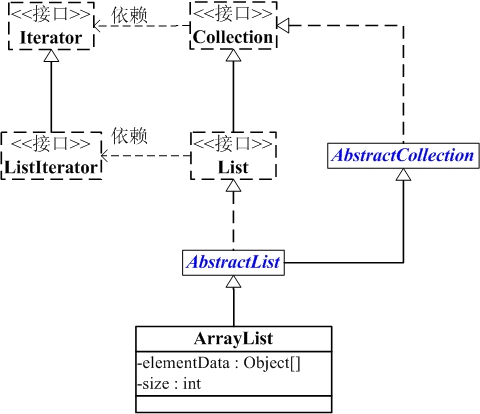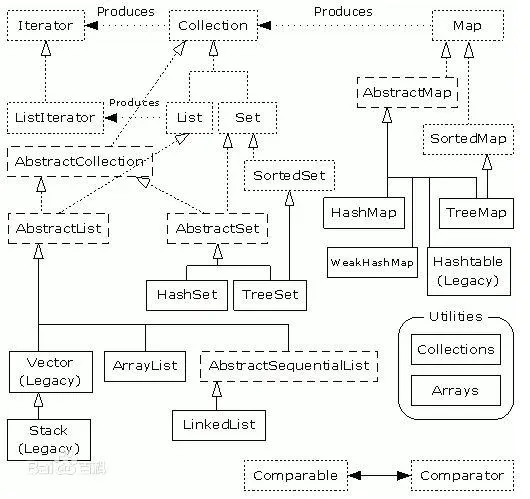概要
上一章,我们学习了Collection的架构。这一章开始,我们对Collection的具体实现类进行讲解;首先,讲解List,而List中ArrayList又最为常用。因此,本章我们讲解ArrayList。先对ArrayList有个整体认识,再学习它的源码,最后再通过例子来学习如何使用它。内容包括:
第1部分 ArrayList简介
第2部分 ArrayList数据结构
第3部分 ArrayList源码解析(基于JDK1.8)
第4部分 ArrayList遍历方式
第1部分 ArrayList介绍
ArrayList简介
ArrayList 是一个数组队列,相当于 动态数组。与Java中的数组相比,它的容量能动态增长。它继承于AbstractList,实现了List, RandomAccess, Cloneable, java.io.Serializable这些接口。
ArrayList _继承了AbstractList,实现了List_。它是一个数组队列,提供了相关的添加、删除、修改、遍历等功能。
ArrayList _实现了RandmoAccess接口,即提供了随机访问功能。_RandmoAccess是java中用来被List实现,为List提供快速访问功能的。在ArrayList中,我们即可以通过元素的序号快速获取元素对象;这就是快速随机访问。稍后,我们会比较List的“快速随机访问”和“通过Iterator迭代器访问”的效率。
ArrayList 实现了Cloneable接口,即覆盖了函数clone(),能被克隆。
ArrayList 实现java.io.Serializable接口,这意味着ArrayList支持序列化,能通过序列化去传输。
和Vector不同,ArrayList中的操作不是线程安全的!所以,建议在单线程中才使用ArrayList,而在多线程中可以选择Vector或者CopyOnWriteArrayList。
ArrayList构造函数
/**
* 当指明初始化数组的大小时,直接将数组初始化为指定容量的数组。
*/
public ArrayList(int initialCapacity) {
if (initialCapacity > 0) {
this.elementData = new Object[initialCapacity];
} else if (initialCapacity == 0) {
this.elementData = EMPTY_ELEMENTDATA;
} else {
throw new IllegalArgumentException("Illegal Capacity: "+
initialCapacity);
}
}
/**
* 当没有指明数组容量时,初始化为空数组。当第一次添加元素时,会扩容为DEFAULT_CAPACITY,也就是容量为10.
*/
public ArrayList() {
this.elementData = DEFAULTCAPACITY_EMPTY_ELEMENTDATA;
}
第2部分 ArrayList数据结构
ArrayList的继承关系

java.lang.Object
↳ java.util.AbstractCollection<E>
↳ java.util.AbstractList<E>
↳ java.util.ArrayList<E>
public class ArrayList<E> extends AbstractList<E>
implements List<E>, RandomAccess, Cloneable, java.io.Serializable {}

ArrayList与Collection关系如下图:
ArrayList包含了两个重要的对象:elementData 和 size。
(01) elementData 是"Object[]类型的数组",它保存了添加到ArrayList中的元素。实际上,elementData是个动态数组,我们能通过构造函数 ArrayList(int initialCapacity)来执行它的初始容量为initialCapacity;如果通过不含参数的构造函数ArrayList()来创建ArrayList,则elementData会初始化为空数组(上面构造函数源码),当第一次添加元素时,会扩容至默认容量10。
(02) size 则是动态数组的实际大小。
第3部分 ArrayList源码解析(基于JDK1.8)
为了更了解ArrayList的原理,下面对ArrayList源码代码作出分析。ArrayList是通过数组实现的,源码比较容易理解。


public class ArrayList<E> extends AbstractList<E>
implements List<E>, RandomAccess, Cloneable, java.io.Serializable
{
private static final long serialVersionUID = 8683452581122892189L;
/**
* Default initial capacity.
*/
private static final int DEFAULT_CAPACITY = 10;
/**
* Shared empty array instance used for empty instances.
*/
private static final Object[] EMPTY_ELEMENTDATA = {};
private static final Object[] DEFAULTCAPACITY_EMPTY_ELEMENTDATA = {};
/**
* 数组用来存储元素。当new ArrayList时没有指明大小,那么就会使用默认的空数组。
* 当第一次add元素的时候,会将数组容量设为默认值DEFAULT_CAPACITY 10.
*/
transient Object[] elementData; // non-private to simplify nested class access
/**
* 数组所包含的元素个数,注意和elementData.length区别开。
*size<=length
* @serial
*/
private int size;
/**
* 当指明初始化数组的大小时,直接将数组初始化为指定容量的数组。
*/
public ArrayList(int initialCapacity) {
if (initialCapacity > 0) {
this.elementData = new Object[initialCapacity];
} else if (initialCapacity == 0) {
this.elementData = EMPTY_ELEMENTDATA;
} else {
throw new IllegalArgumentException("Illegal Capacity: "+
initialCapacity);
}
}
/**
* 当没有指明数组容量时,初始化为空数组。当第一次添加元素时,会扩容为DEFAULT_CAPACITY,也就是容量为10.
*/
public ArrayList() {
this.elementData = DEFAULTCAPACITY_EMPTY_ELEMENTDATA;
}
public ArrayList(Collection<? extends E> c) {
elementData = c.toArray();
if ((size = elementData.length) != 0) {
// c.toArray might (incorrectly) not return Object[] (see 6260652)
if (elementData.getClass() != Object[].class)
elementData = Arrays.copyOf(elementData, size, Object[].class);
} else {
// replace with empty array.
this.elementData = EMPTY_ELEMENTDATA;
}
}
/**
* 将当前数组截成size大小的数组,也就是有元素部分留下,剩下的长度不要了。
*/
public void trimToSize() {
modCount++;
if (size < elementData.length) {
elementData = (size == 0)
? EMPTY_ELEMENTDATA
: Arrays.copyOf(elementData, size);
}
}
/**
* 调整容量。首先判断,如果有必要,则将容量扩大至至少能放下minCapacity个元素。
*/
public void ensureCapacity(int minCapacity) {
/**
* 这里主要确保:如果数组为空,则至少需要扩容到DEFAULT_CAPACITY。
* 如果不为空,扩大至至少能放下minCapacity个元素。
*/
int minExpand = (elementData != DEFAULTCAPACITY_EMPTY_ELEMENTDATA)
? 0
: DEFAULT_CAPACITY;
if (minCapacity > minExpand) {
ensureExplicitCapacity(minCapacity);
}
}
private void ensureCapacityInternal(int minCapacity) {
/**
* 如果数组为空,则要扩大至Math.max(DEFAULT_CAPACITY, minCapacity)
*/
if (elementData == DEFAULTCAPACITY_EMPTY_ELEMENTDATA) {
minCapacity = Math.max(DEFAULT_CAPACITY, minCapacity);
}
ensureExplicitCapacity(minCapacity);
}
private void ensureExplicitCapacity(int minCapacity) {
modCount++;
// 当前要求的个数比当前数组的length要大,则扩容。
if (minCapacity - elementData.length > 0)
grow(minCapacity);
}
/**
* The maximum size of array to allocate.
* Some VMs reserve some header words in an array.
* Attempts to allocate larger arrays may result in
* OutOfMemoryError: Requested array size exceeds VM limit
*/
private static final int MAX_ARRAY_SIZE = Integer.MAX_VALUE - 8;
/**
* 扩容,保证最少可以存放minCapacity个元素。基本原则是扩容至数组长度的1.5倍
*/
private void grow(int minCapacity) {
// overflow-conscious code
//当前数组长度(容量)
int oldCapacity = elementData.length;
//新容量是当前数组容量的1.5倍。
int newCapacity = oldCapacity + (oldCapacity >> 1);
//如果1.5倍的新容量都比minCapacity小,那么新容量就为minCapacity
if (newCapacity - minCapacity < 0)
newCapacity = minCapacity;
/**
* 新容量比最大数组容量还要大的时候,就要重新赋值新容量了。不能超过最大值。
*/
if (newCapacity - MAX_ARRAY_SIZE > 0)
newCapacity = hugeCapacity(minCapacity);
// minCapacity is usually close to size, so this is a win:
elementData = Arrays.copyOf(elementData, newCapacity);
}
private static int hugeCapacity(int minCapacity) {
if (minCapacity < 0) // overflow
throw new OutOfMemoryError();
return (minCapacity > MAX_ARRAY_SIZE) ?
Integer.MAX_VALUE :
MAX_ARRAY_SIZE;
}
public int size() {
return size;
}
public boolean isEmpty() {
return size == 0;
}
public boolean contains(Object o) {
return indexOf(o) >= 0;
}
/**
* 找出元素的位置,可以看出ArrayList可以存放null
*/
public int indexOf(Object o) {
if (o == null) {
for (int i = 0; i < size; i++)
if (elementData[i]==null)
return i;
} else {
for (int i = 0; i < size; i++)
if (o.equals(elementData[i]))
return i;
}
return -1;
}
public int lastIndexOf(Object o) {
if (o == null) {
for (int i = size-1; i >= 0; i--)
if (elementData[i]==null)
return i;
} else {
for (int i = size-1; i >= 0; i--)
if (o.equals(elementData[i]))
return i;
}
return -1;
}
/**
* 克隆的时候,数组得单独克隆
*/
public Object clone() {
try {
ArrayList<?> v = (ArrayList<?>) super.clone();
v.elementData = Arrays.copyOf(elementData, size);
v.modCount = 0;
return v;
} catch (CloneNotSupportedException e) {
// this shouldn't happen, since we are Cloneable
throw new InternalError(e);
}
}
public Object[] toArray() {
return Arrays.copyOf(elementData, size);
}
@SuppressWarnings("unchecked")
public <T> T[] toArray(T[] a) {
if (a.length < size)
// Make a new array of a's runtime type, but my contents:
return (T[]) Arrays.copyOf(elementData, size, a.getClass());
System.arraycopy(elementData, 0, a, 0, size);
if (a.length > size)
a[size] = null;
return a;
}
// Positional Access Operations
@SuppressWarnings("unchecked")
E elementData(int index) {
return (E) elementData[index];
}
/**
* 按索引得到元素只要判断索引没有越界,就直接返回数组对应元素
*/
public E get(int index) {
rangeCheck(index);
return elementData(index);
}
/**
* 将指定位置的元素换成新元素
*/
public E set(int index, E element) {
rangeCheck(index);
E oldValue = elementData(index);
elementData[index] = element;
return oldValue;
}
/**
* 添加元素,如果是第一次添加,就会扩容到DEFAULT_CAPACITY大小;
* 不是第一次添加也会判断是否需要扩容,基本规则是扩容到当前数组容量的1.5倍。
* modCount会增加
*/
public boolean add(E e) {
ensureCapacityInternal(size + 1); // Increments modCount!!
elementData[size++] = e;
return true;
}
/**
*每次添加都要判断是否需要扩容
* 先将index后的元素后移一个,再插入
* modCount++
*/
public void add(int index, E element) {
rangeCheckForAdd(index);
ensureCapacityInternal(size + 1); // Increments modCount!!
System.arraycopy(elementData, index, elementData, index + 1,
size - index);
elementData[index] = element;
size++;
}
/**
* 删除元素,modCount++
* 将index后的元素往前移,并将最后一个元素置为Null
*/
public E remove(int index) {
rangeCheck(index);
modCount++;
E oldValue = elementData(index);
int numMoved = size - index - 1;
if (numMoved > 0)
System.arraycopy(elementData, index+1, elementData, index,
numMoved);
elementData[--size] = null; // clear to let GC do its work
return oldValue;
}
/**
* 删除指定的元素。该元素可以为null。
*/
public boolean remove(Object o) {
if (o == null) {
for (int index = 0; index < size; index++)
if (elementData[index] == null) {
fastRemove(index);
return true;
}
} else {
for (int index = 0; index < size; index++)
if (o.equals(elementData[index])) {
fastRemove(index);
return true;
}
}
return false;
}
/*
* Private remove method that skips bounds checking and does not
* return the value removed.
*/
private void fastRemove(int index) {
modCount++;
int numMoved = size - index - 1;
if (numMoved > 0)
System.arraycopy(elementData, index+1, elementData, index,
numMoved);
elementData[--size] = null; // clear to let GC do its work
}
/**
* 将所有元素置为Null
*/
public void clear() {
modCount++;
// clear to let GC do its work
for (int i = 0; i < size; i++)
elementData[i] = null;
size = 0;
}
/**
* Appends all of the elements in the specified collection to the end of
* this list, in the order that they are returned by the
* specified collection's Iterator. The behavior of this operation is
* undefined if the specified collection is modified while the operation
* is in progress. (This implies that the behavior of this call is
* undefined if the specified collection is this list, and this
* list is nonempty.)
*
* @param c collection containing elements to be added to this list
* @return <tt>true</tt> if this list changed as a result of the call
* @throws NullPointerException if the specified collection is null
*/
public boolean addAll(Collection<? extends E> c) {
Object[] a = c.toArray();
int numNew = a.length;
ensureCapacityInternal(size + numNew); // Increments modCount
System.arraycopy(a, 0, elementData, size, numNew);
size += numNew;
return numNew != 0;
}
/**
* Inserts all of the elements in the specified collection into this
* list, starting at the specified position. Shifts the element
* currently at that position (if any) and any subsequent elements to
* the right (increases their indices). The new elements will appear
* in the list in the order that they are returned by the
* specified collection's iterator.
*
* @param index index at which to insert the first element from the
* specified collection
* @param c collection containing elements to be added to this list
* @return <tt>true</tt> if this list changed as a result of the call
* @throws IndexOutOfBoundsException {@inheritDoc}
* @throws NullPointerException if the specified collection is null
*/
public boolean addAll(int index, Collection<? extends E> c) {
rangeCheckForAdd(index);
Object[] a = c.toArray();
int numNew = a.length;
ensureCapacityInternal(size + numNew); // Increments modCount
int numMoved = size - index;
if (numMoved > 0)
System.arraycopy(elementData, index, elementData, index + numNew,
numMoved);
System.arraycopy(a, 0, elementData, index, numNew);
size += numNew;
return numNew != 0;
}
/**
* Removes from this list all of the elements whose index is between
* {@code fromIndex}, inclusive, and {@code toIndex}, exclusive.
* Shifts any succeeding elements to the left (reduces their index).
* This call shortens the list by {@code (toIndex - fromIndex)} elements.
* (If {@code toIndex==fromIndex}, this operation has no effect.)
*
* @throws IndexOutOfBoundsException if {@code fromIndex} or
* {@code toIndex} is out of range
* ({@code fromIndex < 0 ||
* fromIndex >= size() ||
* toIndex > size() ||
* toIndex < fromIndex})
*/
protected void removeRange(int fromIndex, int toIndex) {
modCount++;
int numMoved = size - toIndex;
System.arraycopy(elementData, toIndex, elementData, fromIndex,
numMoved);
// clear to let GC do its work
int newSize = size - (toIndex-fromIndex);
for (int i = newSize; i < size; i++) {
elementData[i] = null;
}
size = newSize;
}
/**
* Checks if the given index is in range. If not, throws an appropriate
* runtime exception. This method does *not* check if the index is
* negative: It is always used immediately prior to an array access,
* which throws an ArrayIndexOutOfBoundsException if index is negative.
*/
private void rangeCheck(int index) {
if (index >= size)
throw new IndexOutOfBoundsException(outOfBoundsMsg(index));
}
/**
* A version of rangeCheck used by add and addAll.
*/
private void rangeCheckForAdd(int index) {
if (index > size || index < 0)
throw new IndexOutOfBoundsException(outOfBoundsMsg(index));
}
/**
* Constructs an IndexOutOfBoundsException detail message.
* Of the many possible refactorings of the error handling code,
* this "outlining" performs best with both server and client VMs.
*/
private String outOfBoundsMsg(int index) {
return "Index: "+index+", Size: "+size;
}
/**
* Removes from this list all of its elements that are contained in the
* specified collection.
*
* @param c collection containing elements to be removed from this list
* @return {@code true} if this list changed as a result of the call
* @throws ClassCastException if the class of an element of this list
* is incompatible with the specified collection
* (<a href="Collection.html#optional-restrictions">optional</a>)
* @throws NullPointerException if this list contains a null element and the
* specified collection does not permit null elements
* (<a href="Collection.html#optional-restrictions">optional</a>),
* or if the specified collection is null
* @see Collection#contains(Object)
*/
public boolean removeAll(Collection<?> c) {
Objects.requireNonNull(c);
return batchRemove(c, false);
}
/**
* Retains only the elements in this list that are contained in the
* specified collection. In other words, removes from this list all
* of its elements that are not contained in the specified collection.
*
* @param c collection containing elements to be retained in this list
* @return {@code true} if this list changed as a result of the call
* @throws ClassCastException if the class of an element of this list
* is incompatible with the specified collection
* (<a href="Collection.html#optional-restrictions">optional</a>)
* @throws NullPointerException if this list contains a null element and the
* specified collection does not permit null elements
* (<a href="Collection.html#optional-restrictions">optional</a>),
* or if the specified collection is null
* @see Collection#contains(Object)
*/
public boolean retainAll(Collection<?> c) {
Objects.requireNonNull(c);
return batchRemove(c, true);
}
private boolean batchRemove(Collection<?> c, boolean complement) {
final Object[] elementData = this.elementData;
int r = 0, w = 0;
boolean modified = false;
try {
for (; r < size; r++)
if (c.contains(elementData[r]) == complement)
elementData[w++] = elementData[r];
} finally {
// Preserve behavioral compatibility with AbstractCollection,
// even if c.contains() throws.
if (r != size) {
System.arraycopy(elementData, r,
elementData, w,
size - r);
w += size - r;
}
if (w != size) {
// clear to let GC do its work
for (int i = w; i < size; i++)
elementData[i] = null;
modCount += size - w;
size = w;
modified = true;
}
}
return modified;
}
/**
* Save the state of the <tt>ArrayList</tt> instance to a stream (that
* is, serialize it).
*
* @serialData The length of the array backing the <tt>ArrayList</tt>
* instance is emitted (int), followed by all of its elements
* (each an <tt>Object</tt>) in the proper order.
*/
private void writeObject(java.io.ObjectOutputStream s)
throws java.io.IOException{
// Write out element count, and any hidden stuff
int expectedModCount = modCount;
s.defaultWriteObject();
// Write out size as capacity for behavioural compatibility with clone()
s.writeInt(size);
// Write out all elements in the proper order.
for (int i=0; i<size; i++) {
s.writeObject(elementData[i]);
}
if (modCount != expectedModCount) {
throw new ConcurrentModificationException();
}
}
/**
* Reconstitute the <tt>ArrayList</tt> instance from a stream (that is,
* deserialize it).
*/
private void readObject(java.io.ObjectInputStream s)
throws java.io.IOException, ClassNotFoundException {
elementData = EMPTY_ELEMENTDATA;
// Read in size, and any hidden stuff
s.defaultReadObject();
// Read in capacity
s.readInt(); // ignored
if (size > 0) {
// be like clone(), allocate array based upon size not capacity
ensureCapacityInternal(size);
Object[] a = elementData;
// Read in all elements in the proper order.
for (int i=0; i<size; i++) {
a[i] = s.readObject();
}
}
}
/**
* Returns a list iterator over the elements in this list (in proper
* sequence), starting at the specified position in the list.
* The specified index indicates the first element that would be
* returned by an initial call to {@link ListIterator#next next}.
* An initial call to {@link ListIterator#previous previous} would
* return the element with the specified index minus one.
*
* <p>The returned list iterator is <a href="#fail-fast"><i>fail-fast</i></a>.
*
* @throws IndexOutOfBoundsException {@inheritDoc}
*/
public ListIterator<E> listIterator(int index) {
if (index < 0 || index > size)
throw new IndexOutOfBoundsException("Index: "+index);
return new ListItr(index);
}
/**
* Returns a list iterator over the elements in this list (in proper
* sequence).
*
* <p>The returned list iterator is <a href="#fail-fast"><i>fail-fast</i></a>.
*
* @see #listIterator(int)
*/
public ListIterator<E> listIterator() {
return new ListItr(0);
}
/**
* Returns an iterator over the elements in this list in proper sequence.
*
* <p>The returned iterator is <a href="#fail-fast"><i>fail-fast</i></a>.
*
* @return an iterator over the elements in this list in proper sequence
*/
public Iterator<E> iterator() {
return new Itr();
}
/**
* 迭代器中有expectedModCount
*/
private class Itr implements Iterator<E> {
int cursor; // 下一个返回元素的下标,默认是0
int lastRet = -1; // 上一个返回元素的下标。-1表示还没有返回
int expectedModCount = modCount;
public boolean hasNext() {
return cursor != size;
}
@SuppressWarnings("unchecked")
public E next() {
/**
* 检查expectedModCount与modCount是否相等,不相等表示已经被修改过,抛出异常
*/
checkForComodification();
int i = cursor;
if (i >= size)
throw new NoSuchElementException();
Object[] elementData = ArrayList.this.elementData;
if (i >= elementData.length)
throw new ConcurrentModificationException();
cursor = i + 1;
return (E) elementData[lastRet = i];
}
View Code
总结:
(01) ArrayList 实际上是通过一个数组去保存数据的。当我们构造ArrayList时;若使用默认构造函数,会先分配一个空数组,当第一次添加时,则扩容为默认容量大小10。
(02) 当ArrayList容量不足以容纳全部元素时,ArrayList会重新设置容量:newCapacity = oldCapacity + (oldCapacity >> 1)。也就是为原数组容量的1.5倍。(如果超过最大容量,就设为最大容量)
(03) ArrayList的克隆函数,即是将全部元素克隆到一个数组中。
(04) ArrayList实现java.io.Serializable的方式。当写入到输出流时,先写入“容量”,再依次写入“每一个元素”;当读出输入流时,先读取“容量”,再依次读取“每一个元素”。
(05)源码中有个modCount变量,每做一次修改,都会增加一个。在迭代器中有expectedModCount变量,变量时会判断这两个变量是否相同。如果不相同,表示在遍历过程中,数组被修改过,抛出异常。fail-fast
第4部分 ArrayList遍历方式
ArrayList支持3种遍历方式
(01) 第一种,通过迭代器遍历。即通过Iterator去遍历。
Integer value = null;
Iterator iter = list.iterator();
while (iter.hasNext()) {
value = (Integer)iter.next();
}
(02) 第二种,随机访问,通过索引值去遍历。
由于ArrayList实现了RandomAccess接口,它支持通过索引值去随机访问元素。
Integer value = null;
int size = list.size();
for (int i=0; i<size; i++) {
value = (Integer)list.get(i);
}
(03) 第三种,for循环遍历。如下:
Integer value = null;
for (Integer integ:list) {
value = integ;
}
下面通过一个实例,比较这3种方式的效率,实例代码(ArrayListRandomAccessTest.java)如下:
 View Code
View Code
运行结果:
iteratorThroughRandomAccess:3 ms
iteratorThroughIterator:8 ms
iteratorThroughFor2:5 ms
由此可见,遍历ArrayList时,使用随机访问(即,通过索引序号访问)效率最高,而使用迭代器的效率最低!
参考:http://www.cnblogs.com/skywang12345/p/3308556.html,这篇文章是1.6,本文1.8













